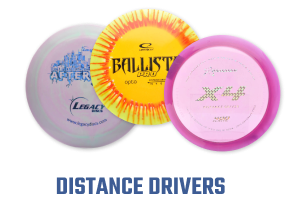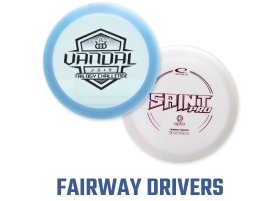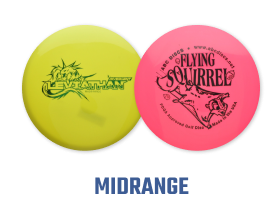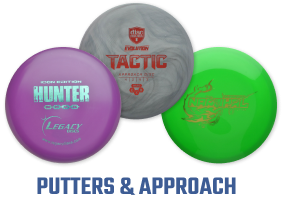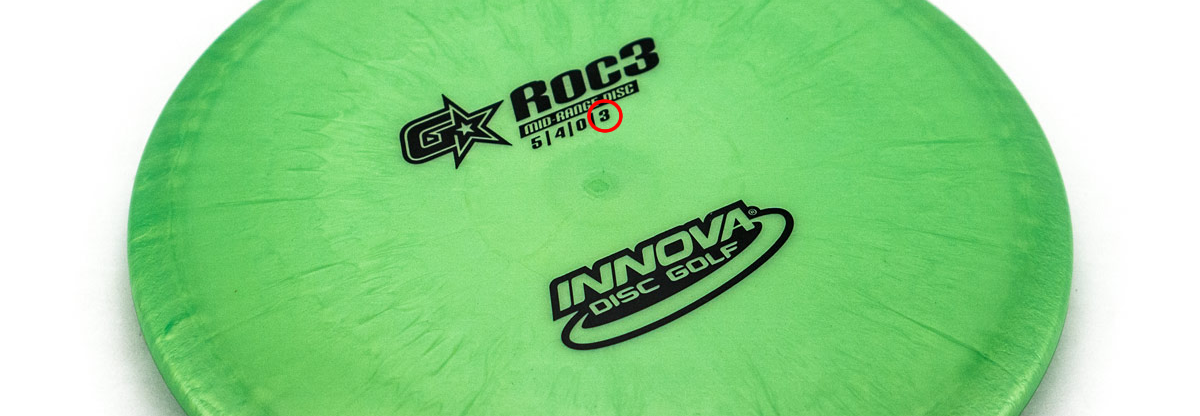
Fade, the fourth and final number in the traditional disc flight rating shown on the Innova Roc3 (5/4/0/3) above, is what a disc does at the end of flight when the forward velocity and rotation start to slow down. Fade is measured on a scale from 0 (least) to 5 (most).
What Is Fade?
Fade is a measure of how sensitive a disc’s flight angle is to a reduction of speed and rotation. As a disc slows down towards the end of flight, the edge of the disc (left edge for a RHBH/LHFH throw, right edge for a LHBH/RHFH throw) will begin to dip, causing a change in the direction of flight. You can imagine Fade as someone pulling the flight path to the side at the end of flight. A strong pull (Fade 5) will cause the disc to change a lot. A weak pull (Fade 1) will affect only a small change in the flight path.
Here are some examples of flight paths for different Fade ratings:
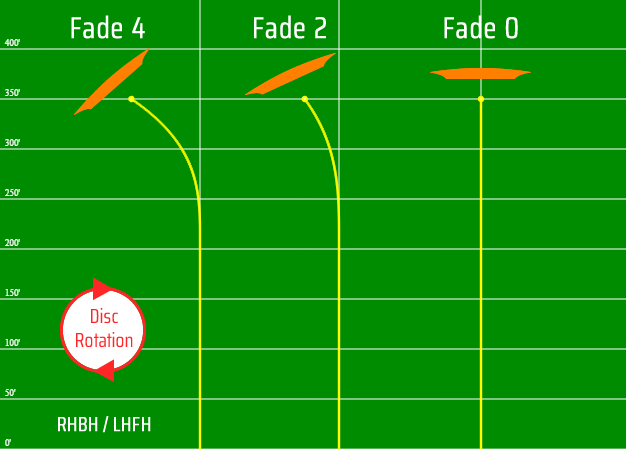
The image above simulates flight paths for three different discs. For simplicity, each disc is thrown RHBH/LHFH and is assumed to have a Turn of 0, meaning it will fly straight during the early part of flight (read more about Turn ratings here).
The flight on the left has a high Fade rating of 4, so the disc will angle down severely at the end of flight, causing a sharp hook as the disc slows down and approaches the ground.
The flight in the middle has a medium Fade rating of 2, so the disc will dip less towards the ground and will demonstrate a softer hook at the end of flight.
The flight on the right has a Fade rating of 0, meaning the disc should change it’s flight angle very little if at all, and should continue mostly straight until it hits the ground. In practice, only a disc thrown perfectly flat and parallel to the ground will fly like this and most discs – even with a Fade 0 – bend a little at the end of flight.
Just as with Turn, if you are left-handed (LHBH/RHFH) all the directions will be reversed and the flight paths will fade to the right instead of the left.
All Fade Is Not Equal
It is important to set appropriate expectations for your discs. When I first started playing and began to understand flight ratings, I expected any disc with flight ratings of ?/?/0/3 to fade a lot at the end of flight. The reality, however, is that high-Speed discs are a lot more sensitive to Fade than low-Speed discs are (read more about Speed ratings here). The below graphic demonstrates this:

This graphic shows the flight paths of two different discs, both with Turn and Fade of 0/3. The path on the left is a Speed 14 disc thrown very hard, and demonstrating a significant hook at the end of the flight. The path on the right is a Speed 2 putter thrown with a good amount of power, but with a much softer hook at the end.
There will be many situations where you need a lot of hook on your shot, but the shot is also short. Many approach shots require a lot of hook at the end to avoid obstacles and land within putting range of the basket. In these situations you can try some or all of the following:
- Always use a high Fade disc with a low Turn (?/?/0/3, ?/?/0/4 for example)
- Throw a higher Speed disc with less power.
- Throw a lower Speed disc with more hyzer (release angle in the direction you want the disc to hook).
- Throw the disc higher in the air and with a significant amount of hyzer angle.
Any of these techniques will take advantage of a high Fade discs’s desire to hook at the end of flight, and will help you sculpt your flight path to get closer to the basket.
Fade for Different Situations
Different situations call for different Fade ratings. Sometimes you want a disc with a high Fade, and sometimes you want a disc with low Fade. Here are some situations (RHBH/LHFH):
- If you want the disc to skip and continue flying hard to the left, try a high Speed, high Fade disc. The Discraft Force (12/5/0/3) is great for long-distance skip shots.
- If you want to put anhyzer on your disc but still want it to come back to the left, use a high Fade disc to pull the disc angle away from the anhyzer release at the end of flight.
- Use a high Fade disc if you have a dog-leg in the fairway or a basket hidden around a corner.
- Use a low Fade disc if you want the disc to turn to the right and not come back much. The Innova Wombat3 (5/5/-1/0) is an example of a disc that will naturally want to go right and stay right when thrown RHBH/LHFH.
- Use a low Fade disc for tunnel shots where a lot of hook at the end could send your disc deep into the woods. The Innova Mako3 (5/5/0/0) or Discraft Buzzz (5/4/-1/1) thrown flat are great for these types of shots.
- Anytime you have OB (water, roads, marked OB, etc), use a high Fade disc to make sure the disc finishes in the direction opposite the OB. Throw RHBH/LHFH if the OB is on the right, and LHBH/RHFH if the OB is on the left.
- If your target is on a hillside you can use a high Fade disc so the flight will bring the disc hard into the hillside and discourage any rolling away from the target.
As Always, Practice
There are many situations where the Fade of the disc you choose to throw will have a significant effect on the outcome. The best way to learn is to go out to your nearest field with a variety of discs with different Speed and Fade ratings and see how they fly for you. See what it takes for you to get a big hook at the end of flight. The more familiar you are with your discs the more comfortable you’ll be when you need to make decisions on the course.

